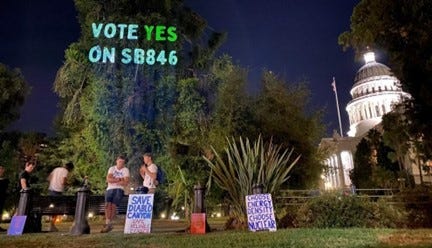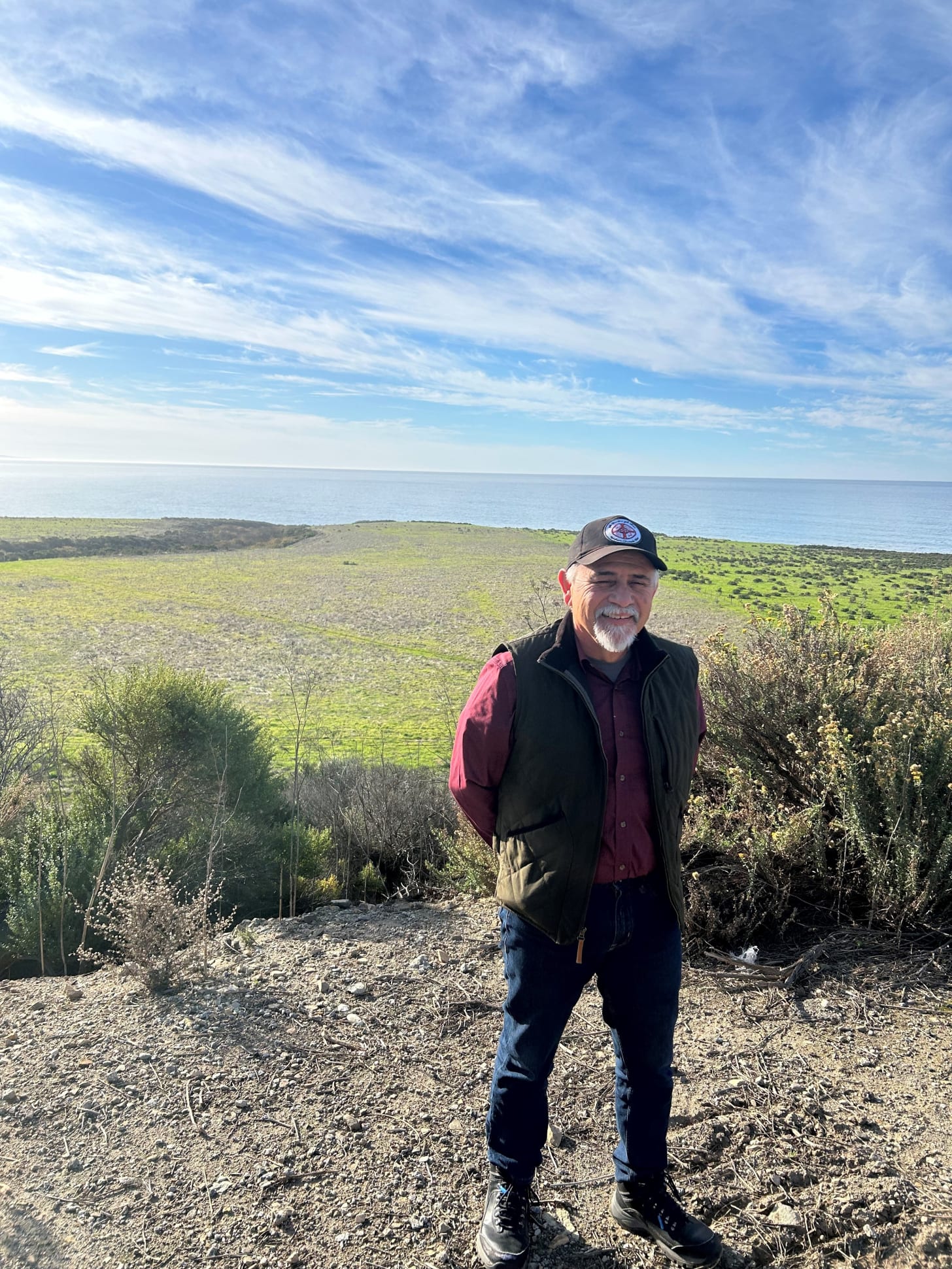PG&E’s Amelioration for ytt Northern Chumash Tribe - Part 2
Pacific Gas & Electric, California and Governor Gavin Newsom have a historic opportunity to facilitate the return of a meaningful amount of land to the Indigenous people of California’s Central Coast
RE-CAP OF PART 1
Part 1 of this 2-part series ((25) PG&E’s Amelioration for ytt Northern Chumash Tribe - Part 1) examined a portion of the Indigenous history of California and yak tityutityu yak tiłhini Northern Chumash Tribe (“ytt Tribe”). Part 1 also explored the history of nuclear power in California and the political controversy surrounding the Diablo Canyon [Nuclear] Power Plant (“DCPP”), leading to the 2016 decision by Pacific Gas & Electric Company (“PG&E”) to shut down DCPP at the end of its operating license in 2025. The imminent closure of DCPP signaled the emergence of a potential opportunity for ytt Tribe to re-acquire a small portion of their ancestral lands. PG&E indicated that they did not have any desire to retain the 12,000 acres surrounding DCPP after the plant is decommissioned.
ytt Tribe partnered with the Land Conservancy of San Luis Obispo County (“SLO Land Conservancy”) and California Polytechnic State University (“Cal Poly”), herein collectively called “ytt Tribe Conservation MOU,” to prepare the ‘Joint Land Acquisition Proposal to Acquire and Protect the Pecho Coast Lands’ (“Joint Land Acquisition Proposal”). In June 2021, the Joint Land Acquisition Proposal submitted to PG&E, proposed that after DCPP is decommissioned, ytt Tribe would purchase the DCPP site and the adjoining approximately 12,000 acres, thereby restoring a small, but salient, portion of the ancestral homeland to ytt Tribe, approximately 250 years after the Spanish began to colonize the lands. The proposed transaction would also create a conservation easement covering most of the 12,000 acres, to be administered by the SLO Land Conservancy. And thus, this intriguing story continues…
Copyright 2024 Douglas C. Sandridge
ENERGY SOBRIETY & THE FIGHT TO SAVE DIABLO CANYON
Just as ytt Tribe was on the cusp of a seemingly perfect deal to acquire some of its native lands, global environmental concerns and an emerging recognition of energy realities were about to imperil the important “Land Back” transaction. At the time that PG&E announced its decision to close DCPP, many environmentalists were doubling-down on their dire CO2 and climate predictions. The State of California had established extremely ambitious goals for reducing CO2 emissions. In 2016, when the closure was announced, DCPP provided approximately 9% of California’s total electricity and approximately 23% of California’s revered low carbon electricity. Simultaneously, many in the public were beginning to appreciate the importance of safe, reliable, affordable electricity. Likewise, a growing number of climate activists were also beginning to recognize the reality that wind and solar energy alone could not power California at an industrial scale.
A public policy think tank called Environmental Progress and certain environmental organizations accurately concluded that a vibrant clean energy economy in California would require much more nuclear energy, not less. Californians for Green Nuclear Power was one of the first organizations to publicly advocate to keep DCPP open. PG&E publicly (and disingenuously) testified that closing DCPP would not cause any increase in the use of natural gas for electricity generation. Nevertheless, most energy-sober experts understood the folly of PG&E’s statements about natural gas and accurately anticipated that closing nuclear power plants, like DCPP, would inevitably open the door for more natural gas power generation and consequently more CO2 emissions (New York’s carbon intensity increased 35% the month after Indian Point Nuclear Power Plant was closed in 2021, due to the increased use of natural gas power generation).
Consequently, a growing coalition of academics, climate activists, policymakers and energy professionals began to appreciate the importance of saving existing nuclear power plants, including DCPP. In 2015, rumors began to emerge about the possible closure of DCPP. Heather Hoff, a nuclear power plant operator and Kristin Zaitz, a civil engineer were both working at DCPP in late 2015 when they detected subtle corporate policy changes which seemed to confirm the rumors that DCPP might not continue pursuing a license extension. Hoff and Zaitz inherently understood the importance of their own work at DCPP producing safe, reliable, affordable, clean electricity from nuclear energy.
In January 2016, several authors of “An Ecomodernist Manifesto” signed an open letter to California Governor Jerry Brown and PG&E urging that DCPP not be closed, arguing that DCPP was an essential asset for achieving state climate goals. Hoff discovered a website called Save Diablo Canyon which had been launched by Michael Shellenberger, the founder of Environmental Progress. Hoff reached out to Shellenberger and they agreed to hold a public meeting in San Luis Obispo to discuss the safety of DCPP and the possibility of extending the life of the plant.
“Save Diablo” Meeting held on February 16, 2016.
Recognizing how important it was to save one of California’s largest sources of low-carbon electricity, on Earth Day 2016 (April 22nd), Hoff and Zaitz formed a transformative organization called Mothers for Nuclear. “We started the organization in a preemptive effort to head-off apparent plans to close Diablo Canyon and build support for keeping the power plant open,” Hoff said. Nevertheless, just two months later on June 21st, 2016, PG&E formally confirmed the worst-kept secret in California and announced its intention to close DCPP by August 2025.
From 2016 until 2018 Mothers for Nuclear, Environmental Progress and others bravely fought a seemingly hopeless battle to save DCPP. With a Democratic stranglehold on California politics and entrenched anti-nuclear ideologies, the fight for DCPP stalled. It was a devastating blow when the local IBEW Electrical Workers Union signed the agreement to close DCPP. IBEW’s decision was incomprehensible to many plant supporters and employees and demotivated the other workers to keep fighting to save the power plant. The California Public Utilities Commission approved the plan to close DCPP on January 11, 2018.
In 2018, a new initiative called Standup for Nuclear came to life under the Environmental Progress umbrella. Paris Ortiz-Wines became the global organizer, focused on mobilizing nuclear advocates worldwide to outwardly campaign for the protection and expansion of nuclear energy. Founded in California, Stand Up for Nuclear was highly motivated to save DCPP.
In 2019, California began to experience shortages of electricity, which escalated to rolling brownouts and eventually a blackout affecting two million customers in the autumn of 2020. As public concern turned to outrage over blackouts, there were indications that Governor Newsom’s office might be willing to reconsider its position on closing DCPP. In 2020, the world’s first nuclear influencer known as Isodope (Isabelle Boemeke) began to make TikTok videos about nuclear energy. Based in California, Isodope was charismatic and eager to join the fight to save DCPP. She began to contact prominent pro-nuclear organizations to rally support. Isodope ultimately joined forces with Mothers for Nuclear and Stand Up for Nuclear to create a dedicated coalition of organizations and individuals focused on saving DCPP. In September 2020, following the recent California electricity blackout, Paris Ortiz-Wines, created the “Save Diablo Canyon” WhatsApp group as a way of coordinating and mobilizing a broad coalition of the people and organizations advocating to keep DCPP open.
Standup for Nuclear, Mothers for Nuclear, Save Diablo Canyon, Californians for Green Nuclear Power, Isodope and others persevered and led a campaign aimed at influencing California policymakers. Slowly, events would converge in favor of saving DCPP. In October 2021 the California Energy Commission and California Independent Service Operator publicly stated that California might have blackouts in future years as a result of the closure of DCPP. With the encouragement of the Clean Air Task Force, (a Massachusetts-based environmental organization), on November 8th, 2021, MIT and Stanford University released a Joint Report [diablocanyonnuclearplant_report_11.19.21.pdf - Google Drive], which concluded that keeping DCPP open would reduce future CO2 emissions and reduce electricity costs in California.
On February 1, 2022, Save Clean Energy wrote a letter, endorsed by 80 academics and previous Secretaries of Energy, calling for Newsom to extend the life of DCPP. Motivated by fear of further blackouts and inundated by so much broad and credible support for DCPP, in April, 2022 Newson publicly announced that he was reconsidering the closure of DCPP.
By August 2022, the cascade of support for DCPP resulted in proposed legislation in the California State Senate to delay closure of DCPP. The proposed legislation precipitated public hearings to discuss the closure of DCPP. Standup for Nuclear, Mothers for Nuclear, Generation Atomic and Isodope mobilized supporters to attend and testify at the hearings in support of DCPP. These organizations also mobilized advocates to aggressively rebut nuclear opposition in order to send a signal to legislators that DCPP had strong support. On September 1, 2022, over two-thirds of the California State Assembly and Senate passed Senate Bill 846, allowing DCPP to continue operating for at least another 5 years. The following day, Newsom signed Senate Bill 846 into law, thereby providing a path to extend operations at DCPP. Subsequently, an application was made to extend DCPP’s operating license for an additional 20 years.
“The grass-roots community organizing efforts undertaken by Stand-up for Nuclear, Mothers for Nuclear, Save Diablo Canyon, Isodope and others not only raised public awareness about the importance of saving Diablo Canyon, these organizations also provided lawmakers the oxygen and vocabulary needed to justify and defend their support for saving the Diablo Canyon.”
Ryan Pickering, Energy Policy Researcher
DIABLO’s REPRIEVE BECOMES A SET-BACK FOR ytt TRIBE
Prior to the extraordinarily successful efforts to save and extend the life of DCPP, it appeared that PG&E and ytt Tribe were heading for a historic agreement to allow ytt Tribe to re-acquire approximately 12,000 acres of its ancestral homeland. Indeed, the Vision Statement prepared by the Diablo Canyon Decommissioning Engagement Panel clearly states that ytt Tribe’s Joint Proposal to Acquire and Protect the Pecho Coast “……was under consideration until the passage of SB 846.”
However, the same Senate Bill which saved DCPP, also muddied the waters for the ytt Tribe “Land Back” deal. In an obvious effort to retain momentum for a transaction to sell the Diablo Canyon lands to ytt Tribe, SB 846 originally provided the following:
SEC. 9. Section 712.
(o) …… It is the intent of the Legislature that the existing efforts to transfer lands owned by the operator and Eureka Energy shall not be impeded by the extension of the Diablo Canyon powerplant.
(v) The efforts to transfer lands owned by the operator [PG&E] and Eureka Energy, …….shall not be impeded by the extension of the operation of the Diablo Canyon power plant.
Regrettably, at the 11th hour, Senate Bill 846 was amended to win additional support by adding the following:
SEC. 13.
(a) The appropriation by the Legislature, the sum of $10,000,000 dollars shall be available in the 2023–24 fiscal year, and the sum of $150,000,000 dollars shall be available in the 2024–25 fiscal year to support a Land Conservation and Economic Development Plan developed by the Natural Resources Agency…….
The amendment to SB 846 contemplates that the State of California would form a commission (and spend millions of dollars) to determine the fate of the 12,000 acres. In other words, Section 13 of SB 846 directly contradicts the original intent of the bill and directly impedes the private land transaction contemplated between PG&E to ytt Tribe.
Admittedly, it is still technically possible that after all of the bureaucratic intervention and years of delays, ytt Tribe could ultimately end up acquiring the Diablo Canyon lands. However, it is also more likely that powerful and influential organizations like Sierra Club, and The Nature Conservancy will find a way to acquire these important Indigenous lands instead of ytt Tribe.
Notwithstanding PG&E’s decision to keep DCPP open, ytt Tribe clearly wants to continue pursuing a transaction to purchase the 12,000 acres. ytt Tribe imagines that perhaps they could still purchase the land and then lease-back to PG&E whatever portion of the land that is necessary to facilitate the continued operation and eventual decommissioning of DCPP. This solution would still be a win-win for all legitimately interested parties. ytt Tribe believes that having the Tribe own their sacred land together with a conservation easement held by SLO Land Conservancy is still the best way to simultaneously protect the heritage of the tribe, provide managed public access and promote conservation of the 12,000-acre area.
“The Diablo Canyon lands are part of the un-ceded sovereign territory of ytt Tribe. It’s our inherent stewardship responsibility to assure its cultural, natural and man-made resources endure for the next 7 generations,” stated Scott Lathrop, the CEO of ytt Tribe’s nonprofit, and emphasized “ytt Tribe is committed to retaining this sacred duty and will not concede it to any individual, corporation, land trust, conservation, or public entity.”
ytt Tribal member Scott Lathrop standing on the land upon which his ancestors once lived until the arrival of the Spanish in the 18th Century. The historical village site of tsɨtʸɨwɨ is located on Diablo Canyon lands.
In an attempt to retain momentum for the Land Back deal, Tribal Chair Mona Olivas Tucker sent an impassioned personal message to California Governor Gavin Newsom inviting him to the Pecho Coast and imploring him to allow ytt Tribe to move forward with the acquisition of the 12,000 acres.
YAK TITʸU TITʸU YAK TIŁHINI (YTT) NORTHERN CHUMASH TRIBAL CHAIRWOMAN'S INVITATION TO GOVERNOR NEWSOM
youtu.be Unfortunately, according to Tucker, Newsom has not acknowledged the video or the invitation.
By all accounts, PG&E would still be willing to move forward with the original proposal to sell the land to ytt Tribe Conservation MOU if the State of California would step aside and cease interfering with the transaction, or better yet, California could actively assist the ytt Tribe with the purchase. Understandably, PG&E relies on the goodwill of the State of California in order to continue operating. Therefore, PG&E will not likely agree to sell the land to ytt Tribe Conservation MOU unless California explicitly green-lights the transaction.
NEWSOM & CALIFORNIA – JUST DO THE RIGHT THING!
While Indigenous peoples’ desire to reclaim their ancestral lands is understandable, the political realities today make such aspirations difficult to achieve. 500 years after the first European settlers permanently arrived in North American and 345 million inhabitants later, restoring all lands to Native Americans is practically unachievable.
Nevertheless, occasionally fortuitous circumstances reveal rare opportunities to return some small portion of Indigenous lands to the descendants of the ancestral owners.One such opportunity has presented itself on California’s Pecho Coast, the ancient and traditional homeland of ytt Tribe.ytt Tribe recognizes that the land is bountiful, teaming with wildlife, biodiversity and worthy of conservation and protection.ytt Tribe is also humbly self-aware and recognizes that their stewardship of these lands alone might be beyond the scope of its current ytt Tribal membership.Hence, in recognition of its need to preserve and protect the natural ecosystems, ytt Tribe has developed a compelling and practical plan to perpetually preserve and protect the lands in partnership with the SLO Land Conservancy and Cal Poly.
PG&E seems poised to facilitate this “Land Back” transaction. However, the State of California, non-governmental organizations and other non-tribal entities are aggressively undermining a private land transaction between PG&E and ytt Tribe. This aggressive intervention heightens the likelihood that the Diablo Canyon Lands could be sold or gifted to one or more so-called environmental groups and/or governmental entities instead of ytt Tribe.
The Vision Statement of the Diablo Canyon Decommissioning Engagement Panel “recommends that the CPUC Tribal Lands Transfer Policy be implemented, as appropriate on the Diablo Canyon Lands.” This unfortunate setback for a land transaction could all be rectified if California would simply step aside and allow ytt Tribe and PG&E to consummate the private Land Back transaction, which has already been proposed. This transaction would be good for PG&E’s stockholders and ratepayers and especially ytt Tribe. Likewise, a private transaction would not cost the tax payers of California anything. Better yet, in the spirit of historical justice, California should gift the $160 million appropriated in SB 846 to ytt Tribe Conservation MOU and allow PG&E and ytt Tribe Conservation MOU to proceed with an important and historic Land Back transaction.
On June 18th, 2019 Governor Gavin Newsom issued an apology to Native Americans for the state’s historical wrongdoings and established a Truth & Healing Council. Energy Ruminations implores Newsom and the State of California to put their money where their mouths are and do the right thing by stepping aside to allow PG&E and ytt Tribe Conservation MOU to move forward with a private agreement that could be funded by SB 846 to return the 12,000 acres to ytt Tribe! The ytt Tribe should be allowed to regain this land instead of the Sierra Club. It is obviously not within Newsom’s power to rectify all the injustices of the past, but it is certainly within his power to facilitate this common-sense Land Back transaction for ytt Tribe.
The author would like to express a special acknowledgement of appreciation to Mark Nelson, Radiant Energy Group, for his wide-ranging efforts and contributions to save nuclear power plants across the globe, including Diablo Canyon. Mark was a trusted advisor to Michael Shellenberger at Environmental Progress and has been a key influencer in the development and success of Stand-Up for Nuclear and many other nuclear advocacy organizations. Mark has also been an extraordinary mentor for me along my personal journey of nuclear advocacy.
Also, a special acknowledgement and thanks to the following additional people whose advice, personal knowledge and experiences helped make this important article possible:
Mona Olivas Tucker, Chair, ytt Tribe
Scott Lathrop, CEO of ytt Northern Chumash Non-Profit
Wendy Lucas, Vice President of ytt Northern Chumash Non-Profit
Paris Ortiz-Wines, Executive Director of Stand-Up for Nuclear
Heather Hoff, Co-Founder of Mothers for Nuclear
Ryan Pickering, Energy Policy Researcher
Emmet Penney, Author & Host of the Nuclear Barbarians Podcast
Jack Austin, Radiant Energy Group
Tim Smyth, Nuclear Energy Advocate
Rececca Tuhus-Dubrow, Freelance Journalist & Author of Atomic Dreams










Thank goodness the state reversed the decision to shut down DCPP. That plant is the safest most cost efficient and reliable nuclear plant in the country.
20 more years, not just 5! Let’s GO!